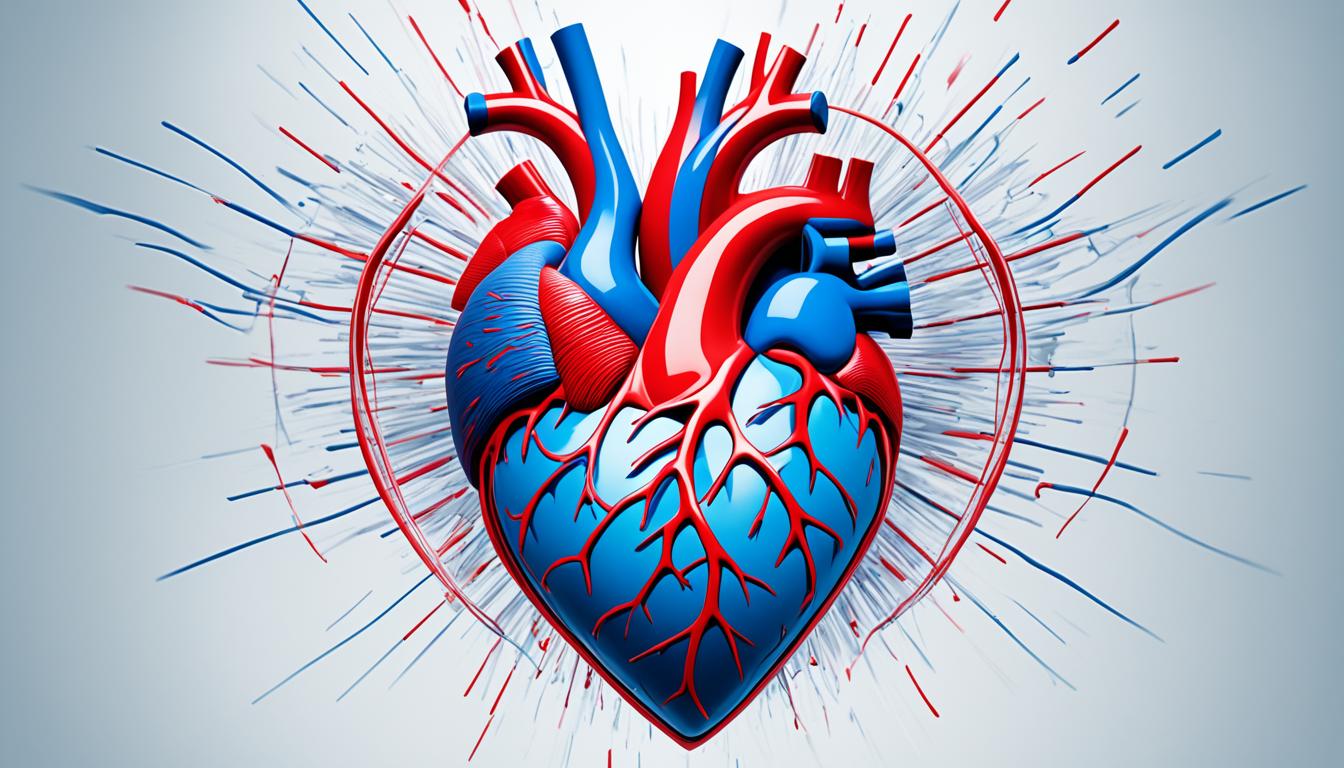Sudden cardiac death (SCD) is when the heart suddenly stops, causing the person to stop breathing and faint. Sadly, this can lead to death. It’s a major cause of natural deaths worldwide. In the US, over 300,000 adults die from it each year.
A sudden heart rhythm problem triggers SCD. This problem stops the heart from pumping blood properly. As a result, the heart might beat too fast or not regularly.
Doctors find it hard to know when someone will have this heart issue. But, if it happens, quick CPR and using a defibrillator can save them by fixing their heart’s rhythm.
Key Takeaways:
- Sudden cardiac death (SCD) is a heart arrhythmia condition that leads to a sudden cessation of heart function and can result in death.
- SCD is caused by a sudden cardiac arrest, which disrupts the heart’s electrical system and affects its ability to pump blood.
- Diagnosing and preventing SCD can be challenging due to the unpredictable nature of arrhythmias.
- Immediate CPR and defibrillation are necessary for treating sudden cardiac arrest and restoring normal heart rhythm.
- Research on stem cell therapy aims to explore new treatment options for cardiac arrest-induced heart damage.
Common Causes and Symptoms of Sudden Cardiac Arrest
Sudden cardiac arrest (SCA) is when the heart suddenly stops working. The electrical signals in the heart go wrong, making the heart’s rhythm erratic. This stops the heart from working properly and becomes a medical emergency. Knowing what causes and the signs of SCA is important. Early spotting and quick help mean more lives saved.
Causes of Sudden Cardiac Arrest
SCA can happen for different reasons, such as:
- Coronary artery disease blocks or narrows blood vessel supplying the heart.
- A heart attack stops blood flow, hurting the heart muscle.
- Heart rhythm issues, like ventricular fibrillation, can cause it.
- Certain heart problems, like big heart chambers, can make it more likely.
- Family history and genetics play a role for some.
- Drugs, like cocaine, can make SCA more possible.
This shows why it’s vital to treat heart conditions and lower risks to stop SCA.
Symptoms of Sudden Cardiac Arrest
SCA can happen suddenly, but some signs might show up first. These could include:
- Feeling pressure or pain in the chest.
- Being weak or tired more than usual.
- Having trouble breathing.
- Feeling your heart beating irregularly.
- Feeling dizzy or faint.
- Passing out.
It’s key to know symptoms can be different for each person. Not everyone sees these warning signs. If you notice any of these in yourself or someone else, get help right away.
Treatment and Prevention of Sudden Cardiac Arrest
Immediate action is key when sudden cardiac arrest happens. The main treatment is CPR and defibrillation. These steps aim to get the heart back to a normal rhythm.
CPR keeps blood and oxygen moving to vital organs. Start CPR quickly to boost survival odds. Defibrillation uses a machine to shock the heart, fixing its rhythm.
In the hospital, more steps are taken to prevent problems. Lowering the patient’s body temperature can protect the brain. This method is called therapeutic hypothermia.
Doctors also use medicines to control the heart’s rhythm. These drugs help keep the heart’s electrical signals in order. The right drug and dose depend on the person’s health.
Sometimes, an ICD might be needed for those at high risk. This device can shock the heart back to a normal beat. It stops sudden cardiac arrest in its tracks.
To prevent sudden cardiac arrest, managing heart health is crucial. This includes good eating, regular exercise, and managing stress. Also, if needed, medicines can help reduce risks.
Changing your lifestyle can significantly reduce sudden cardiac arrest risks. Be sure to eat well, exercise, and keep stress low. Avoiding smoking and excessive weight is also important.
If you have risks, talk to your doctor often. They can help with heart attack prevention tactics and watch your heart’s health. A good partnership with your healthcare provider is crucial.
Combining quick action, proper treatment, and a healthy lifestyle is the best way to fight against sudden cardiac arrest. This approach supports a healthier heart.
| Treatment and Prevention Strategies | Summary |
|---|---|
| CPR and defibrillation | Immediate life-saving interventions to restore normal heart rhythm |
| Therapeutic hypothermia | Lowers body temperature to protect the brain from damage |
| Anti-arrhythmic drugs | Medication to control abnormal heart rhythms |
| Implantable cardioverter-defibrillator (ICD) | Monitors heart rhythm and delivers electric shocks when necessary |
| Lifestyle changes | Healthy eating, regular exercise, stress management, and weight control |
Stem Cell Therapy for Cardiac Arrest
Researchers are looking into how stem cell therapy might help treat cardiac arrest. They’re studying stem cells from embryos and those made in labs. These cells can turn into heart muscle cells, aiding in heart function.
The goal is to use these special cells to fix the heart. They are looking at ways to combine them with new methods, including growing heart tissue in the lab. This could be a game changer for patients with heart issues.
Studies are ongoing to learn more about the role of genes in sudden heart failure. At the same time, new treatments are being explored. Stem cell therapy is at the forefront, offering hope for those with heart rhythm problems.

